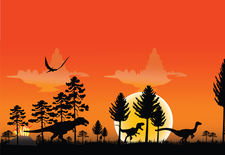Clonezilla partition clone and backup tool
Jurassic Park

© Andreas Meyer, 123RF
Clonezilla Live backs up and clones complete partitions or hard disks. The popular live system comes with an easy-to-use interface.
Listening to the heads on your hard disk clicking when the disk fails is bad enough as it is, but worse things are still to come. Although buying and installing a replacement disk is unlikely to faze most users, this is just the start of a time-consuming installation marathon that can easily take a day or two to restore the whole system with your personal preferences and favorite wallpaper. Having a backup copy of the whole disk means that you can carry on with your work after about an hour, just as if nothing had gone wrong.
Preservatives
Retailers offer a variety of programs that will create a full backup with the press of a button, but these programs cost money. The open source Clonezilla [1] is an alternative to proprietary tools such as True Image, Drive Image, and Norton Ghost. Clonezilla will read a partition or your whole disk bit by bit and store the results in a (fairly large) file known as an image or write directly to a second medium. This allows you to clone a disk fairly quickly, which is handy if you are moving to a new computer and want to take your old system with you.
Clonezilla comes in two flavors: Clonezilla Live, which boots from a CD; or a bootable USB stick, which backs up a partition on another medium attached to your computer and is your best choice for everyday work. If needed, Clonezilla Live will back images up to the network, for example an NFS, SSH, or Samba server. This is really useful on home or school networks where you could store drive images on a small NAS. Clonezilla Server Edition can even clone the disks in multiple computers simultaneously over a network, but it requires a special environment to do so (see the "Clonezilla SE" box).
[...]
Buy Linux Magazine
Subscribe to our Linux Newsletters
Find Linux and Open Source Jobs
Subscribe to our ADMIN Newsletters
Support Our Work
Linux Magazine content is made possible with support from readers like you. Please consider contributing when you’ve found an article to be beneficial.

News
-
TrueNAS 25.04 Arrives with Thousands of Changes
One of the most popular Linux-based NAS solutions has rolled out the latest edition, based on Ubuntu 25.04.
-
Fedora 42 Available with Two New Spins
The latest release from the Fedora Project includes the usual updates, a new kernel, an official KDE Plasma spin, and a new System76 spin.
-
So Long, ArcoLinux
The ArcoLinux distribution is the latest Linux distribution to shut down.
-
What Open Source Pros Look for in a Job Role
Learn what professionals in technical and non-technical roles say is most important when seeking a new position.
-
Asahi Linux Runs into Issues with M4 Support
Due to Apple Silicon changes, the Asahi Linux project is at odds with adding support for the M4 chips.
-
Plasma 6.3.4 Now Available
Although not a major release, Plasma 6.3.4 does fix some bugs and offer a subtle change for the Plasma sidebar.
-
Linux Kernel 6.15 First Release Candidate Now Available
Linux Torvalds has announced that the release candidate for the final release of the Linux 6.15 series is now available.
-
Akamai Will Host kernel.org
The organization dedicated to cloud-based solutions has agreed to host kernel.org to deliver long-term stability for the development team.
-
Linux Kernel 6.14 Released
The latest Linux kernel has arrived with extra Rust support and more.
-
EndeavorOS Mercury Neo Available
A new release from the EndeavorOS team ships with Plasma 6.3 and other goodies.

